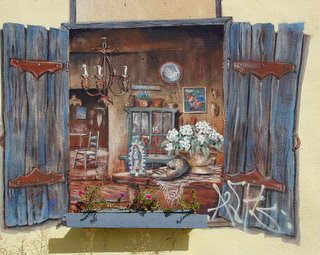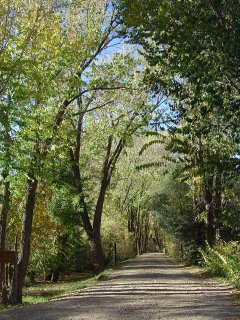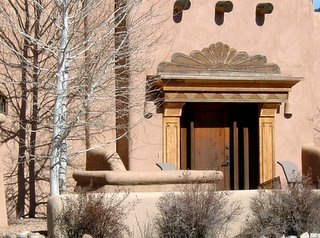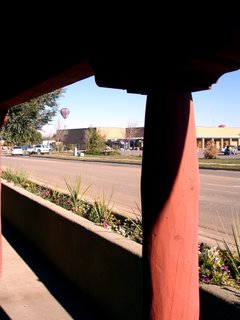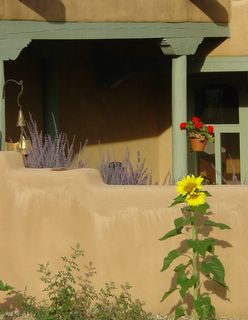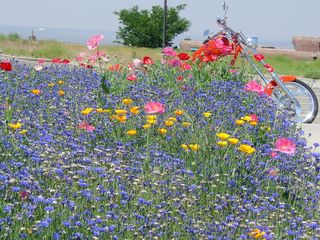
Wednesday, December 14, 2005
Tuesday, December 13, 2005
Wednesday, December 07, 2005
Monday, November 14, 2005
Sunday, November 06, 2005
Sunday, September 18, 2005
Saturday, September 03, 2005
Monday, August 29, 2005
Sunday, August 28, 2005
Wednesday, August 24, 2005
Tuesday, August 23, 2005
Non-profits in Taos
There are over 225 non-profit organizations in Taos. On a per capita basis, that is 1 for every 26 people living in the Town of Taos, and 1 for every 88 people living in Greater Taos. The remarkable statistics point to both what is good and bad in our community.
Monday, July 18, 2005
Saturday, July 02, 2005
Wednesday, June 29, 2005
Sunday, June 05, 2005
Saturday, May 28, 2005
Friday, May 20, 2005
Extreme Taos
Great insider viewpoint on Taos by Bill Whaley, the editor and publisher The Horsefly: Taos: Extreme Adventure for Visitors & Locals
OldNew Taos
As community leaders debate the decline in tourism, its causes, its remedies, and its politics, the big picture remains fuzzy. Taos, like so many other communities, is trying to reconcile the Old Ways and the New Ways. The Taos Way, with its major subcultural variations (Hispanic, Pueblo, Arts, Old Hippie, Retiree) bumps head on into the forces of the New: globalization (the Walmart World of competitive global markets), shifting demographics (smaller Hispanic families, growing number of retired and semi-retired from outside New Mexico), and the accompanying pressures for accelerated development..
I believe that the underlying question of the tourism debate is how this community deals with the Old Ways and the New Ways. Solutions need not be seen as either/or.
Before I moved to Taos, I was fortunate enough to live in Tokyo for a year. There, I was struck by the extraordinary way in which Old and New are not viewed as mutually exclusive but instead are continuously transformed into a Japanese way. At the most ordinary level, for instance, Japanese distillers market a whiskey named OldNew. More profoundly, there was the question posed by one of my Japanese undergraduate students: “Do you have seasons in America?” Flabbergasted at first, I realized that it wasn’t student ignorance or naivete –-of course there are changes of season outside of Japan. The real question was: “Do you observe/celebrate seasons as an integral part of your life as we do in Japan?”
In Japan, the changing of seasons and the mini-seasons within each season form part and parcel of everyone’s daily life: seasonal changes marked by street and temple festivals, traditional foods and beverages appear, clothing changes, specific colors are featured, sounds of the city change, and particular individual, family, and communal activities change. The all-encompassing changes echo the Old in the context of the New and create a “Japanese season.”
Perhaps there is a unique Taos Way. Although there is no single formulation of the Taos Way, most of us claim to know it when we see it. “That is so Taos.” And I would go a step further: the Taos Way is a unique amalgam of OldNew, often unplanned, serendipitous.
The Taos Landscape. Much of our valued open space and vistas, a concern of modern town planning practices, are sovereign lands of the Taos Pueblo. Consequently, the modern practice of open space designation is embedded in the traditional cultural nexus of the Taos Pueblo. Perhaps this arrangement could be formalized with additional benefits to both Pueblo and Town.
Taos and the Arts. The Taos Art Colony as it has evolved over the past 100 years has acted as bridge between the outsider world and insider world of old Hispanic families and native Americans. The embedding of a world of outsider artists has become part of what makes Taos a unique place as both artist destination and art market.
St. Francis de Assisi Church- Ranchos de Taos. The traditional parish church has also become a tourist and artist destination. Modern tourism has become part of traditional parish life. The Church is one of the distinctive places that tourists and Taosenos identify with Taos.
If there is a Taos Way, can our community find other ways of embedding the New in the Old so as to cherish and preserve the Taos Way? Can we find ways to make development, small and large, more Taos-like? Can we find ways of making our communal landscape more Taos-like? Will we be able to find ways of embedding modern systems of health care, education, and justice into the Taos Way? I believe tourists and residents, long-time and recent Taosenos, would embrace the Taos Way.
I believe that the underlying question of the tourism debate is how this community deals with the Old Ways and the New Ways. Solutions need not be seen as either/or.
Before I moved to Taos, I was fortunate enough to live in Tokyo for a year. There, I was struck by the extraordinary way in which Old and New are not viewed as mutually exclusive but instead are continuously transformed into a Japanese way. At the most ordinary level, for instance, Japanese distillers market a whiskey named OldNew. More profoundly, there was the question posed by one of my Japanese undergraduate students: “Do you have seasons in America?” Flabbergasted at first, I realized that it wasn’t student ignorance or naivete –-of course there are changes of season outside of Japan. The real question was: “Do you observe/celebrate seasons as an integral part of your life as we do in Japan?”
In Japan, the changing of seasons and the mini-seasons within each season form part and parcel of everyone’s daily life: seasonal changes marked by street and temple festivals, traditional foods and beverages appear, clothing changes, specific colors are featured, sounds of the city change, and particular individual, family, and communal activities change. The all-encompassing changes echo the Old in the context of the New and create a “Japanese season.”
Perhaps there is a unique Taos Way. Although there is no single formulation of the Taos Way, most of us claim to know it when we see it. “That is so Taos.” And I would go a step further: the Taos Way is a unique amalgam of OldNew, often unplanned, serendipitous.
The Taos Landscape. Much of our valued open space and vistas, a concern of modern town planning practices, are sovereign lands of the Taos Pueblo. Consequently, the modern practice of open space designation is embedded in the traditional cultural nexus of the Taos Pueblo. Perhaps this arrangement could be formalized with additional benefits to both Pueblo and Town.
Taos and the Arts. The Taos Art Colony as it has evolved over the past 100 years has acted as bridge between the outsider world and insider world of old Hispanic families and native Americans. The embedding of a world of outsider artists has become part of what makes Taos a unique place as both artist destination and art market.
St. Francis de Assisi Church- Ranchos de Taos. The traditional parish church has also become a tourist and artist destination. Modern tourism has become part of traditional parish life. The Church is one of the distinctive places that tourists and Taosenos identify with Taos.
If there is a Taos Way, can our community find other ways of embedding the New in the Old so as to cherish and preserve the Taos Way? Can we find ways to make development, small and large, more Taos-like? Can we find ways of making our communal landscape more Taos-like? Will we be able to find ways of embedding modern systems of health care, education, and justice into the Taos Way? I believe tourists and residents, long-time and recent Taosenos, would embrace the Taos Way.
Thursday, April 07, 2005
Tuesday, April 05, 2005
Taos, The Dark Side
It’s distressing to write about the darker side of Taos: the murder rate among younger people, high school non-graduation rates especially Native Americans, domestic abuse, an epidemic of diabetes, tensions and hostilities between the various cultural groups that make up Northern New Mexico, a school system struggling to measure up, and difficulties transitioning from rule by los primos to a transparent and representative government.
For some, the dark side drives them away. For so many more, we live surrounded by beauty in a truly remarkable community.
For some, the dark side drives them away. For so many more, we live surrounded by beauty in a truly remarkable community.
The Newer Taosenos
So many of the people drawn to Taos are multi-faceted: professional singer turned healer, satellite dish installer who is a sculptor, plumber who is a skilled flint napper, builder who is an advanced ski instructor, Chicago lawyer doing animal husbandry. What people do to earn a living tells you less about the person than in other parts of the country where we’ve lived. Some gatherings are the Upper West Side in the mountains. Taos is a truly remarkable reservoir of talent and knowledge, home grown and more recent arrivals.
Friday, April 01, 2005
Subscribe to:
Posts (Atom)


